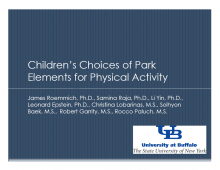We are pleased to announce an exciting new alliance between Active Living Research and GP RED to co-host and coordinate...
Children's Choices of Park Elements for Physical Activity

Presentation at the 2010 Active Living Research Annual Conference
Background:
There is consistent evidence that access to parks is associated with increased youth physical activity. However, these studies do not address how much activity children accrue when they visit a park or which park elements children choose to be active.
Objectives:
To determine the duration of use and intensity of activity while using park elements when children complete a scheduled 1 hour park visit.
Methods:
A total of 106 girls and boys were recruited from a 1 mile neighborhood surrounding the borders of Delaware Park in Buffalo, NY. At the time of abstract submission, data from a total of 89 Hispanic (n=5 boys, n=2 girls), African-American (n=13 boys, n=15 girls), and Caucasian (n=15 boys, n=39 girls) children had been processed and were available for analysis. Delaware park is the largest (350 acres) and most frequently visited (6177 to 7326 visitors/day) city park, and provides a wide diversity in park elements. The surrounding neighborhood is diverse in terms of race/ethnicity with a mean household income of $34,190 and 16.4% of household incomes below the poverty level. Each child was scheduled for a 1-hour period to play at the park with a friend. Children were allowed to bring toys to the park and to be active or rest as they freely choose. Families were met to standardize the starting location of the park visit as different entry locations could influence activity choices. Children were given an overview of the park elements to assure that they were familiar with the possible choices. Targeted elements within Delaware Park were digitized into a GIS map according to an existing park map and verified through field visits. A tablet-PC observation tool was designed to work within GIS. Trained observers created behavioral maps by placing point location markers and coding the physical activity type on the digital map. A new marker was placed any time a child changed location or physical activity. The physical activity intensity (metabolic equivalents, METs) was coded using a compendium of children’s physical activities. MET intensities were categorized as light (<3 METs) and moderate, hard, and very hard (3 and 4.5 and 6 METs).
Results:
Boys and girls did not differ (p>0.14) for age (12.4 vs 11.6 y), zBMI (0.28 vs 0.20 z-score), or SES. There were sex differences (p<0.001) in the proportion of minutes of physical activity at different MET intensities. Boys engaged in less light (15.3 versus 21.2 min) and moderate (14.8 vs 18.0 min) and greater very hard (18.5 versus 9.4 min) activity than girls. There was no sex difference in (11.4 min for sexes) hard activity. Overall boys and girls spent 44.7 and 38.8 min, respectively in moderate-to-vigorous physical activity (MVPA). As shown in the Table, boys spent a greater (p<0.001) proportion of time in sport and playing active games in open green space and courts and a smaller (p<0.001) proportion doing jungle gym, running, walking, standing and sedentary activities. Multilevel regression revealed that the mean MET intensity was greater in boys than girls (p<0.001) and decreased with age (p<0.01).
Conclusions:
When children were provided the opportunity to visit a park for 1 hour, boys and girls engaged in MVPA for 75% and 65% of the time, respectively. Thus, children met the recommended physical activity goals of 60 min/day with MVPA making-up most of the time. This was accomplished while the children were engaged in unstructured free play. Parks can be ideal resources for children to meet recommended activity goals, but children must be provided with the opportunity to play at the park and the park must be designed to provide both built and open space elements that boys and girls will utilize to be physically active.
Support:
Robert Wood Johnson Foundation, Active Living Research grant 42246.
Related Tools & Resources
STAY UP TO DATE
RECENTLY ADDED TOOLS & RESOURCES
MOVE! A BLOG ABOUT ACTIVE LIVING
The "Active Living Conference" aims to break down research and practice silos and...







